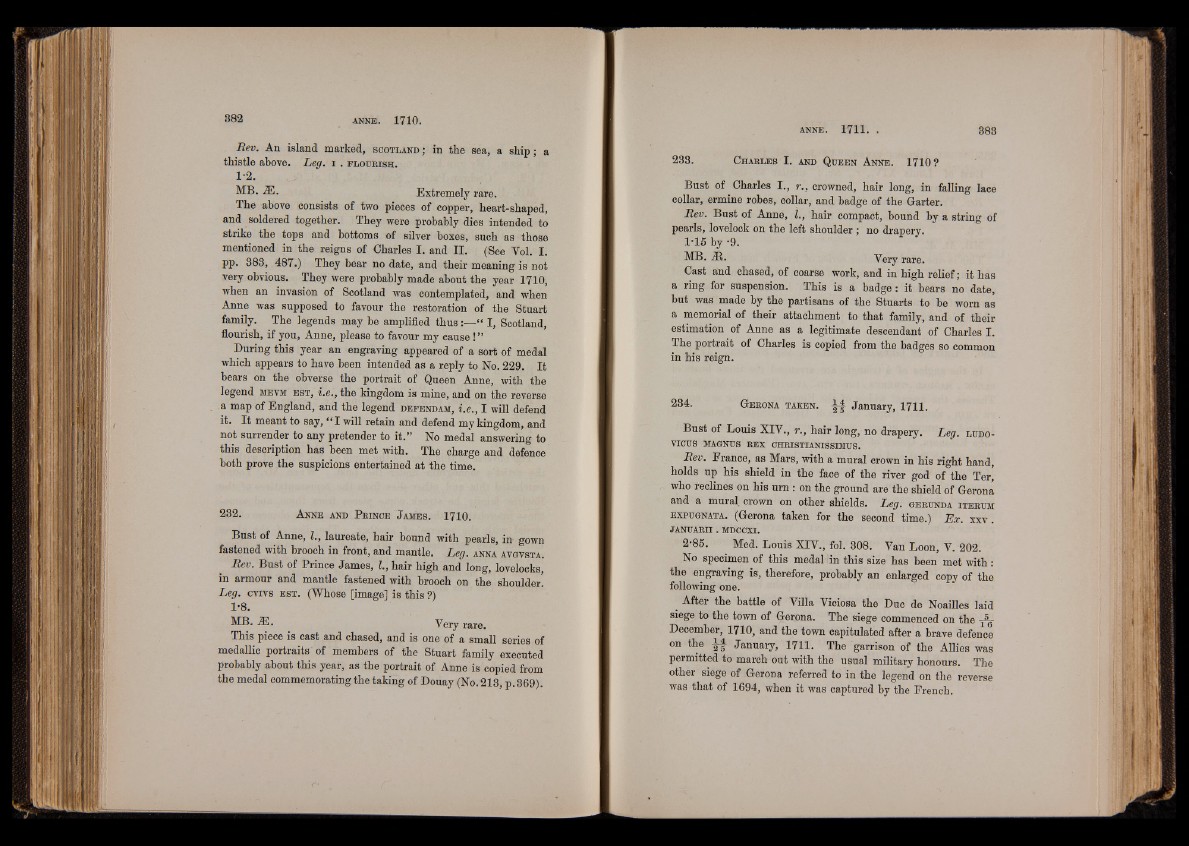
Rev. An island marked, Sc o t l a n d ; in the sea, a ship; a
thistle above. Leg. i . f l o u b is h .
1-2.
MB. 2E. Extremely rare.
The above consists of two pieces of copper, heart-shaped,
and soldered together. They were probably dies intended to
strike the tops and bottoms of silver boxes, such as those
mentioned in the reigns of Charles I. and II. (See Yol. I.
pp. 383, 487.) They bear no date, and their meaning is not
very obvious. They were probably made about the year 1710,
when an invasion of Scotland was contemplated, and when
Anne was supposed to favour the restoration of the Stuart
family. The legends may be amplified t h u s “ I, Scotland,
flourish, if you, Anne, please to favour my cause !”
During this year an engraving appeared of a sort of medal
which appears to have been intended as a reply to No. 229. It
bears on the obverse the portrait of Queen Anne, with the
legend m evm e s t , i.e., the kingdom is mine, and on the reverse
a map of England, and the legend d e f e n d am, i.e., I will defend
it. It meant to say, “ I will retain and defend my kingdom, and
not surrender to any pretender to it.” No medal answering to
this description has been met with. The charge and defence
both prove the suspicions entertained at the time.
2 3 2 . A n n e a n d P e i n c e J a m e s . 1 7 1 0 .
Bust of Anne, I., laureate, hair bound with pearls, in gown
fastened with brooch in front, and mantle. Leg. anna avgvsta .
Rev. Bust of Prince James, I., hair high and long, lovelocks,
in armour and mantle fastened with brooch on the shoulder.
Leg. cvivs e s t . (Whose [image] is this ?)
1-8.
MB. .33. Yery rare.
This piece is cast and chased, and is one of a small series of
medallic portraits of members of the Stuart family executed
probably about this year, as the portrait of Anne is copied from
the medal commemorating the taking of Douay (No. 2 1 3 , p. 3 6 9 ) .
Bust of Charles I., r., crowned, hair long, in falling lace
collar, ermine robes, collar, and badge of the Garter.
Rev. Bust of Anne, I., hair compact, bound by a string of
pearls, lovelock on the left shoulder ; no drapery.
1’15 by ‘9.
MB. ¿1. Very rare.
Cast and chased, of coarse work, and in high relief; it has
a ring for suspension. This is a badge: it bears no date,
but was made by the partisans of the Stuarts to be worn as
a memorial of their attachment to that family, and of their
estimation of Anne as a legitimate descendant of Charles I.
The portrait of Charles is copied from the badges so common
in his reign.
2 3 4 . G e e o n a t a k e n , f f January, 1 7 1 1 .
Bust of Louis XIV., r., hair long, no drapery. Leg. l u d o -
VICUS MAGNUS EEX CHEISTIANISSIMUS.
Rev. France, as Mars, with a mural crown in his right hand,
holds up his shield in the face of the river god of the Ter,
who reclines on his urn : on the ground are the shield of Gerona
and a mural crown on other shields. Leg. g eb u n d a it e e u m
e x pu g n a t a . (Gerona taken for the second time.) Ex. x x v .
JANUABII . MDCCXI.
2-85. Med. Louis XIV., fol. 308. Van Loon, V. 202.
No specimen of this medal in this size has been met with:
the engraving is, therefore, probably an enlarged copy of the
following one.
After the battle of Villa Viciosa the Due de Noailles laid
siege to the town of Gerona. The siege commenced on the
December, 1710, and the town capitulated after a brave defence
on the i f January, 1711. The garrison of the Allies was
permitted to march out with the usual military honours. The
other siege of GeroDa referred to in the legend on the reverse
was that of 1694, when it was captured by the French.